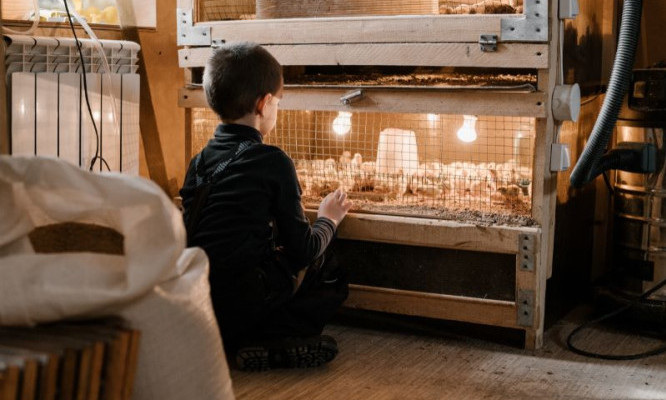Chick brooding essentials is more than just a phase; it’s the cornerstone of raising healthy, vibrant chickens. Understanding the chick brooding essentials for any poultry keeper ensures that the chicks grow into strong and productive birds. Whether you’re at the beginning of your poultry journey or simply brushing up on the fundamentals, this guide is for you.
What is Chick Brooding?
At its core, a chick brooder provides newly hatched chicks with the environment and care they need to thrive during their initial weeks.
It is an impenetrable safety zone that allows your chicks the safety and comfort to flourish, reducing chick death due to avoidable outside threats.
By Definition
A brooder for chicks mimics a mother hen’s warm, protective embrace for chicks, especially during their vulnerable early life.
The Critical Period
The first 5-6 weeks are critical. Chicks are most susceptible to illnesses, temperature fluctuations, and other threats during this window. Their long-term health and productivity can be traced back to the care received during this period.
This is the time when the mother hen, you, will attend to their every whim and whimper, from wiping their bottoms when necessary to cure pasty butt to ensuring they are safe from diseases like coccidiosis.
Setting Up The Perfect Brooder
Your chicks’ first home plays a pivotal role in their growth and development.
But let’s be clear: Nothing is perfect. The perfect brooder is the brooder that works for you.
A brooder can be
- A cardboard box
- A discarded refrigerator, bathtub, or slop sink
- An old bureau with the drawers removed
- A kiddie pool
- An unused puppy playpen
Use your imagination. It will make a fine brooder if it contains and restrains your chicks for 5-6 weeks while they get their feathers.
Location, Location, Location
Whether you opt for an indoor or an outdoor brooder for chicks, ensure it’s free from drafts. Each has its merits: Indoors offers better protection from predators, while outdoor brooding can often offer more space.
Now, listen closely to this. Chicks are dust-making machines. I brooded my last babies in a three-season room because of the low outside temperature. I had them in a 55-gallon container, complete with a plate heater and all of the other essentials. I will NEVER do it again! Just look at the dust. I had to throw out the carpet.

Size Matters
Space is a luxury for fast-growing chicks. Initially, they’ll need about 0.5 square feet each. But remember, they grow quickly!
In six weeks, your baby chicks will be fully feathered and will need room to move around. At Six weeks, you will want to move your young ladies and gents, if you have a rooster, to the coop if it is solely for this particular batch of younglings or to a section of the coop if it is already occupied.
To be happy, an adult chicken needs 2-4 feet of “me-space” in the coop.
Bedding Basics
For a clean, healthy environment, absorbent bedding is key. Straw and wood shavings are top choices. Newspaper is an option, but use it with caution; it can get slippery when wet and has yucky ink.
It’s not a good idea to have a no-bedding setup. Smooth floors can lead to a leg injury.
The best surface for new chicks is one they can get a grip on while not being able to ingest it. Old diapers, puppy pads, or paper towels all work fine. Just remember to keep the brooder clean.
Warmth: Striking the Right Balance
Just like Goldilocks, it’s all about finding what’s just right.
Understanding Chick Thermoregulation
Chicks aren’t great at regulating their body temperature initially. Your role? Helping them strike a balance between too hot and too cold. Too drafty is also a consideration.
Choosing a Heat Source
While traditional heat lamps have been used for years, radiant heat plates are gaining traction due to their safety features. No matter your choice, it’s essential to monitor the temperature regularly.
Chicks will let you know if they are uncomfortable. If they chirp loudly and consistently while huddling near a heat source, guess what? You got it. They are cold.
If they are as far away from the heat as they can get, and they are panting and lethargic? Right again.
They are just right if they are moving about the brooder, smiling, taking selfies, and sharing on Chickbook.
A rule of thumb is to start the brooding temperature at 90-95 degrees Fahrenheit and reduce it by about 5 degrees each week until the brooder reaches ambient temperature.
Nutrition: From Day One and Beyond
Baby chicks will have no problem learning to eat. The innate tendency of chickens is to scratch and peck. The problem is that they will try anything and eventually eat what is given to them, whether it is good for them or not.
Starting them out right will be reflected in later health and productivity.
Starter Feed: What’s the Deal?
Quality starter feed is non-negotiable. Its high protein content provides the necessary nutrients for rapid growth.
Grit and Why It’s Essential
Ever wondered how chicks digest food? Grit is their secret weapon, helping them grind down grains in their gizzard.
Grit is found naturally by chicks in the wild but not in a home brooder. Quality chick starter negates the need for grit, but keeping a separate container with chick grit in it doesn’t hurt to be safe. Don’t worry. The chicks will only eat what they need.
Fresh Water
Hydration is key. But remember, chicks can be clumsy! Use shallow dishes or place small objects in the water to prevent accidental drowning and maintain cleanliness. Think marbles or pebbles.
Common Brooding Challenges (and Solutions!)
Despite our best efforts, challenges can arise. Nothing breaks the heart more than finding one of your new chicks lying lifeless under a heater or stuffed into the corner of the brooder.
Overcrowding
Too many chicks in a small space can lead to stress, disease, suffocation, and even cannibalism. Always ensure ample space.
Earlier in this post, We discussed how much space is needed for chicks and adult birds. Follow those guidelines, and you will be good to go.
Pasty Butt
It’s a sticky situation, literally. This condition can be life-threatening, where droppings stick to a chick’s vent. Regular checks and gentle cleaning are essential.
The most likely reason for pasty or sticky butts is disease, chilling, overheating, or poor nutrition/feed.
Chicks that are shipped experience a lot of stress and stand a very good chance of being chilled. It is important that your newly arrived chicks’ first drink is warm, not cold water.
Very soft food is also a possible cause of pasty butt. Start your chicks out on a high-quality chick scratch for the first day or two before switching to a starter feed.
Chilling and Overheating
Keep an eye out for chicks huddling together (too cold) or spreading out and panting (too hot). Adjust temperatures accordingly.
Safety First: Protecting Chicks from Predators
Predators are always on the prowl, looking for an easy meal.
Chickens are on the menu of just about every predator you can think of. Their protection is in your hands.
Common Predators
From sneaky raccoons to cunning foxes, it’s vital to recognize potential threats.
Chicks are very small and fragile, so larger predators aside, rats, cats, snakes, and careless puppies are also worth consideration.
Predator-proofing the Brooder
Sturdy latches, regular checks, and vigilance are your best allies.
Chick brooding is the foundation of a flourishing flock. As you journey through the nuances of brooding, remember with care, attention, and a sprinkle of patience, you’re setting your chicks up for a bright future. For more detailed insights on chicken care, check out this comprehensive resource.



